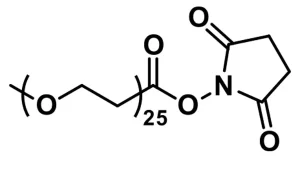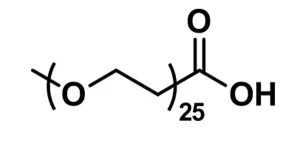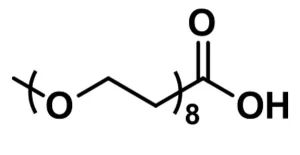m-dPEG®37-NHS ester, product number QBD-10910, is a long (112 atoms, 133.9 Å), methyl-terminated, discrete-length polyethylene glycol (dPEG®) spacer functionalized with an N-hydroxysuccinimidyl (NHS) ester to modify surfaces having accessible free amines.
Free amines react optimally with NHS esters in aqueous media at pH 7.0 – 7.5. In aqueous media, the rate at which the ester hydrolyzes to the carboxylic acid increases with increasing pH. Moreover, it should be noted that reacting surface amines on biomolecules (e.g., proteins and peptides) with this uncharged, methyl-capped dPEG® spacer may alter the overall charge of the resulting conjugates.
m-dPEG®37-NHS ester, product number QBD-10910, has been used successfully to modify silica shelled quantum dots used in imaging applications to make them water-soluble. Also, it has been employed to improve the pharmacokinetic (PK) and biodistribution (BD) properties of an antibody that targets an epitope that is found exclusively in adenocarcinomas. Carbon nanotubes and inorganic nanoparticles with amine-functionalized surfaces could also be modified to passivate the surface and make it hydrophilic. Moreover, proteins and other biomolecules conjugated to this product will have higher water solubility, reduced or eliminated antigenicity, reduced propensity to aggregate, and improved PK and BD properties.
| Unit Size | 100mg, 1000mg |
|---|---|
| Molecular Weight | 1787.07; single compound |
| Chemical formula | C₈₀H₁₅₅NO₄₁ |
| CAS | 756525-94-7 |
| Purity | > 97% |
| Spacers | dPEG® Spacer is 112 atoms and 133.9 Å |
| Shipping | Ambient |
| Typical solubility properties (for additional information contact Customer Support) | Methylene chloride, Acetonitrile, DMAC or DMSO. |
| Storage and handling | -20°C; Always let come to room temperature before opening; be careful to limit exposure to moisture and restore under an inert atmosphere; stock solutions can be prepared with dry solvent and kept for several days (freeze when not in use). dPEG® pegylation compounds are generally hygroscopic and should be treated as such. This will be less noticeable with liquids, but the solids will become tacky and difficult to manipulate, if care is not taken to minimize air exposure. |
Greg T. Hermanson, Bioconjugate Techniques, 3rd Edition, Elsevier, Waltham, MA 02451, 2013, ISBN 978-0-12-382239-0; See Chapter 18, Discrete PEG Reagents, pp. 787-821, for a full overview of the dPEG® products.
Silica-Shelled Single Quantum Dot Micelles as Imaging Probes with Dual or Multimodality. Rumiana Bakalova, Zhivko Zhelev, Ichio Aoki, Hideki Ohba, Yusuke Imai, and Iwao Kanno. Anal. Chem. 2006, 78 (16) pp 5925–5932. July 14, 2006. DOI: 10.1021/ac060412b.
Engineering PEGylated Antibody Fragments for Enhanced Properties and Cancer Detection. Shubham Mangla. Knowledge Bank. 2016, May 2016.
Tuning surface functionalities of Sub-10 nm-sized nanocarriers to target outer retina in designing drug delivery agents for intravitreal administration. Suyeon You, Hyoungtai Kim, Hye-youn Junga, Boram Kim, Eun Jung Lee, Jin Woo Kim, Yoonkyung Kim. Biomaterials. 2020. DOI: 10.1016/j.biomaterials.2020.120188
Applicable patents and legal notices are available at legal notices.




Stay in the Loop. Join Our Online Community
Products
Ordering
About Us
Application
Resources

©Vector Laboratories, Inc. 2025 All Rights Reserved.
To provide the best experiences, we use technologies like cookies to store and/or access device information. Consenting to these technologies will allow us to process data such as browsing behavior or unique IDs on this site. Not consenting or withdrawing consent, may adversely affect certain features and functions. Privacy Statement
How do I Request a Quote?
To request a quote for products: